The Historic Avalanche that Destroyed the Village of Àrreu in 1803, Catalan Pyrenees
Abstract
1. Introduction
- “L’Àrreu a Vós consagrava
- amb vot ses vides i llars
- quan el poble enderrocava
- el riu de neu del Mont-ars;
- dissort pels avis sentida
- no colpira son hereu:
- Defenseu la nostra vida,
- Mare de Déu de la Neu.”
“Este pueblo antes de 1803 se hallaba construido ¼ de hora mas hacia el N; pero habiéndose desprendido en dicho año una gran masa de nieve. la cual arruinó las 10 casas de que entonces constaba, matando a 17 personas, se edificó en el punto que actualmente ocupa por conceptuarlo a cubierto de semejantes catástrofes.”
2. Monars Catchment Area
3. Materials and Methods
3.1. Historical Approach
3.1.1. Compilation of Historical Documentation
3.1.2. Search in the Avalanche Data Base of Catalonia (ICGC)
3.1.3. Site Survey
3.1.4. Interviews to Local Inhabitants
3.2. Morphological Approach
3.2.1. Checking of Aerial Imagery
3.2.2. Terrain and Vegetation Inspection
3.2.3. Dendrogeomorphological Analysis
- Growth suppression—a significant decrease in the growing pace visible on the subsequent tree rings which get temporarily or permanently narrower;
- eccentricity—tree-ring widths of rings on opposite sides of the stem in the leaning direction (upslope and downslope sides) undergo an opposed reaction. In angiosperms (birch, ash, and aspen in the present case), rings on the upslope side of the stem become wider, and on the downslope, narrower. In gimnosperms (pine trees in this case), it is the opposite: Rings become wider on the downslope side, and narrower on the upslope side;
- reaction wood—this kind of wood is produced after the inclination of the stem to help the tree regain the vertical position; which is tension wood in angiosperms and compression wood in gimnosperms;
- scars—the destruction of cambium causes tree rings to be locally absent on this part of the stem. The next tree rings develop from the cambium on the margins of the injury to gradually overgrow and cover the damaged tissue.
3.3. Avalanche Modeling
3.3.1. Dynamic Modeling
3.3.2. Statistical Modeling
4. Results
4.1. The Old Village of Àrreu
4.2. Monars Avalanche Path Characteristics
4.3. 1803 Avalanche Modeling
4.3.1. Simulation with SAMOS-AT
4.3.2. Statistical Approach
5. Discussion
6. Conclusions
7. Epilogue
Author Contributions
Funding
Acknowledgments
Conflicts of Interest
References
- Goigs de la Mare de Déu de la Neu d’Àrreu. Urgell Diocese 19th Century? Available online: https://algunsgoigs.blogspot.com/2014/03/goigs-la-mare-de-deu-de-la-neu-arreu.html (accessed on 7 May 2020).
- Madoz, P. Diccionario Geográfico, Estadístico E histórico de España y sus Posesiones de Ultramar 1845–1850. Available online: http://www.bibliotecavirtualdeandalucia.es/catalogo/es/consulta/registro.cmd?id=6353 (accessed on 7 May 2020).
- De Zamora, F. Respostes de la Vall d’Àneu als Qüestionaris de Francisco de Zamora (1709); Padilla, J.I., Ed.; Garsineu Edicions: Tremp, Spain, 1997. [Google Scholar]
- Muntán, E.; Oller, P. Historic snow avalanches in the Pyrenees: The destruction of the small village of Àrreu (Pallars Sobirà). Z. Wildbach Lawinen Eros. Steinschlagschutz 2019, 183, 152–161. [Google Scholar]
- Oller, P.; Muntán, E.; García-Sellés, C.; Furdada, G.; Baeza, C.; Angulo, C. Characterizing major avalanche episodes in space and time in the twentieth and early twenty-first centuries in the Catalan Pyrenees. Cold Reg. Sci. Technol. 2015, 110, 129–148. [Google Scholar] [CrossRef][Green Version]
- Oller, P.; Marturià, J.; González, J.C.; Escriu, J.; Martínez, P. El servidor de datos de aludes de Cataluña, una herramienta de ayuda a la planificación territorial. In Proceedings of the VI Simposio Nacional sobre Taludes y Laderas Inestables, Valencia, Spain, 21–24 June 2005; pp. 905–916. [Google Scholar]
- McClung, D.M.; Schaerer, P. The Avalanche Handbook, 3rd ed.; The Mountaineers Books: Seattle, WA, USA, 2006; 342p. [Google Scholar]
- Sauermoser, S.; Granig, M.; Kleemayr, K.; Margreth, S. Avalanche dynamics models and impact. In The Technical Avalanche Protection Handbook; Rudolf-Miklau, K., Sauermosser, S., Mears, A.I., Eds.; Wilhelm Ernst & Sohn: Berlin, Germany, 2015; pp. 55–90. [Google Scholar]
- Canadian Avalanche Association. Land Managers Guide to Snow Avalanche Hazards in Canada; Jamieson, J.B., Stethem, C.J., Schaerer, P.A., McClung, D.M., Eds.; CAA: Revelstoke, BC, Canada, 2002. [Google Scholar]
- Schweingruber, F.H. Tree Rings and Environment. Dendroecology; Swiss Federal Institute for Forest, Snow and Landscape Research, Paul Haupt Verlag: Berne, Switzerland, 1996; pp. 183–196. [Google Scholar]
- Germain, D.; Hétu, B.; Filion, L. Tree-ring based reconstruction of past snow-avalanche events and risk assessment in northern Gaspé Peninsula (Québec, Canada). In Tree Rings and Natural Hazards A State of the Art Advances in Global Change Research, 1st ed.; Stoffel, M., Bollschweiler, M., Butler, D.R., Luckman, B.H., Eds.; Springer: Dordrecht, The Netherlands, 2010; Volume 41, pp. 51–73. [Google Scholar]
- Stoffel, M.; Bollschweiler, M. Tree-ring analysis in natural hazards research—An overview. Nat. Hazards Earth Syst. Sci. 2008, 8, 187–202. [Google Scholar] [CrossRef]
- Shroder, J.F. Dendrogeomorphological analysis of mass movement on Table Cliffs Plateau, Utah. Quat. Res. 1978, 9, 168–185. [Google Scholar] [CrossRef]
- Muntán, E.; Andreu, L.; Oller, P.; Gutiérrez, E.; Martínez, P. Dendrochronological study of the Canal del Roc Roig avalanche path: First results of the Aludex project in the Pyrenees. Ann. Glaciol. 2004, 38, 173–179. [Google Scholar] [CrossRef][Green Version]
- Stokes, M.A.; Smiley, T.L. An Introduction to Tree-Ring Dating; University of Chicago Press: Chicago, IL, USA, 1968; 73p. [Google Scholar]
- Lied, K.; Bakkehøi, S. Empirical calculations of snow-avalanche run-out distance based on topographic parameters. J. Glaciol. 1980, 26, 165–178. [Google Scholar] [CrossRef][Green Version]
- Furdada, G.; Vilaplana, J.M. Statistical prediction of maximum avalanche run-out distances from topographic data in the western Catalan Pyrenees (northeast Spain). Ann. Glaciol. 1998, 26, 285–288. [Google Scholar] [CrossRef]
- Zwinger, T.; Kluwick, A.; Sampl, P. Simulation of Dry-Snow Avalanche Flow over Natural Terrain. In Dynamic Response of Granular and Porous Materials under Large and Catastrophic Deformations; Lecture Notes in Applied and Computational Mechanics; Hutter, K., Kirchner, N., Eds.; Springer: Heidelberg, Germany, 2003; Volume 11, pp. 161–194. [Google Scholar]
- Sampl, P.; Zwinger, T. Avalanche simulation with SAMOS. Ann. Glaciol. 2004, 38, 393–398. [Google Scholar] [CrossRef]
- Fischer, J.-T. A novel approach to evaluate and compare computational snow avalanche simulation. Nat. Hazards Earth Syst. Sci. 2013, 13, 1655–1667. [Google Scholar] [CrossRef]
- Fischer, J.T.; Fromm, R.; Gauer, P.; Sovilla, B. Evaluation of probabilistic snow avalanche simulation ensembles with Doppler radar observations. Cold Reg. Sci. Technol. 2014, 97, 151–158. [Google Scholar] [CrossRef]
- Fischer, J.T.; Kofler, A.; Fellin, W.; Granig, M.; Kleemayr, K. Multivariate parameter optimization for computational snow avalanche simulation. J. Glaciol. 2015, 61, 875–888. [Google Scholar] [CrossRef]
- Gauer, P.; Kronholm, K.; Lied, K.; Kristensen, K.; Bakkehoi, S. Can we learn more form the data underlying the statistical—Model with respect to the dynamical behaviour of avalanches? Cold Reg. Sci. Technol. 2010, 62, 42–54. [Google Scholar] [CrossRef]
- Muntán, E.; García, C.; Oller, P.; Martí, G.; García, A.; Gutiérrez, E. Reconstructing snow avalanches in the Southeastern Pyrenees. Nat. Hazards Earth Syst. Sci. 2009, 9, 1599–1612. [Google Scholar] [CrossRef]
- Butler, D.R.; Sawyer, C.F. Dendrogeomorphology and high-magnitude snow avalanches: A review and case study. Nat. Hazards Earth Syst. Sci. 2008, 8, 303–309. [Google Scholar] [CrossRef]
- Johnson, E.A. The relative importance of snow avalanche disturbance and thinning on canopy plant populations. Ecology 1987, 68, 43–53. [Google Scholar] [CrossRef]
- Salm, B.; Burkard, A.; Gubler, H. Berechnung von Fliesslawinen, eine Anleitung für Praktiker mit Beispielen; Eigdenössichen Institut für Schnee- und Lawinenforschung SLF: Davos, Switzerland, 1990. [Google Scholar]
- Bühler, Y.; von Rickenbach, D.; Stoffel, A.; Margreth, S.; Stoffel, L.; Christen, M. Automated snow avalanche release area delineation—Validation of existing algorithms and proposition of a new object-based approach for large-scale hazard indication mapping. Nat. Hazards Earth Syst. Sci. 2018, 18, 3235–3251. [Google Scholar] [CrossRef]
- Rapin, F. A new scale for avalanche intensity. In Proceedings of the International Snow Science Workshop, Pencticton, BC, Canada, 29 September–4 October 2002; pp. 90–96. [Google Scholar]
- Issler, D.; Gauer, P.; Schaer, M.; Keller, S. Inferences on Mixed Snow Avalanches from Field Observations. Geosciences 2020, 10, 2. [Google Scholar] [CrossRef]
- Sinickas, A.; Jamieson, B. Comparing methods for estimating β points for use in statistical snow avalanche runout models. Cold Reg. Sci. Technol. 2014, 104–105, 23–32. [Google Scholar] [CrossRef]
- Jamieson, B.; Jones, A.; Sinickas, A. Statistical runout estimation. In Planning Methods for Assessing and Mitigating Snow Avalanche Risk; Jamieson, B., Ed.; Canadian Avalanche Association: Revelstoke, BC, Canada, 2018; pp. 79–96. [Google Scholar]
- Canadian Avalanche Association. Observation Guidelines and Recording Standards for Weather Snowpack and Avalanches; Canadian Avalanche Association: Revelstoke, BC, Canada, 2016. [Google Scholar]
- Meffre, J.F. 8 fébrier 1996, au fond d’une petite vallée d’Andorre engoncée sous un mètre de neige. In Les Risques Naturels en Montagne; Naaim-Bouvet, F., Richard, D.C., Eds.; Éditions Quae: Versalles Cedex, France, 2015; pp. 124–125. [Google Scholar]
- Furdada, G.; Margalef, A.; Trapero, L.; Pons, M.; Areny, F.; Baró, M.; Reyes, A.; Guinau, M. The Avalanche of Les Fonts d’Arinsal (Andorra): An example of a Pure Powder, Dry Snow Avalanche. Geosciences 2020, 10, 126. [Google Scholar] [CrossRef]
- Christen, M.; Kowalski, J.; Bartelt, P. RAMMS: Numerical simulation of dense snow avalanches in three-dimensional terrain. Cold Reg. Sci. Technol. 2010, 63, 1–14. [Google Scholar] [CrossRef]
- Faug, T.; Turnbull, B.; Gauer, P. Looking beyond the powder/dense flow avalanche dichotomy. J. Geophys. Res. Earth Surf. 2018, 123, 1183–1186. [Google Scholar] [CrossRef]
- Bonnefoy, M.; Barral, L.; Cabos, S.; Escande, S.; Gaucher, R.; Pasquier, X.; Richard, D. The localization map of avalanche phenomena (CLPA): Stakes and prospects. In Proceedings of the ISSW 2010, Lake Tahoe, CA, USA, 17–22 October 2010; pp. 699–705. [Google Scholar]
- Jamieson, B.; Campbell, C. Avalanche Mapping. In Planning Methods for Assessing and Mitigating Snow Avalanche Risk; Jamieson, B., Ed.; Canadian Avalanche Association: Revelstoke, BC, Canada, 2018; pp. 189–212. [Google Scholar]
- Bolós, J.; Hurtado, V. Atles dels Comtats de Pallars i Ribagorça (v. 806–v.998); Rafael Dalmau Editor: Barcelona, Spain, 2012; 165p. [Google Scholar]
- Rella, F. Les Valls d’Àneu; Edicions El Mèdol: Tarragona, Spain, 1993; 391p. [Google Scholar]
- Ancey, C.; Rapin, F.; Martin, E.; Coleou, C.; Naaim, M.; Brugnot, G. L’avalanche de Péclerey du 9 février 1999. La Houille Blanche 2000, 5, 45–53. [Google Scholar] [CrossRef][Green Version]
- MEDDE. Plan de Prevention des Risques Naturels. Avalanches; Ministère de l’Écologie, du Développement durable et de l’Énergie: Paris, France, 2015; 101p. [Google Scholar]
- OFDT-OFEG-OFEFP. Aménagement du Territoire et Dangers Naturels; Office Fédéral du Développement Territorial, Office Fédéral des Eaux et de la géologie, Office Fédéral de L’environnement, des Forêts et du Paysage: Berne, Switzerland, 2005; 48p. [Google Scholar]
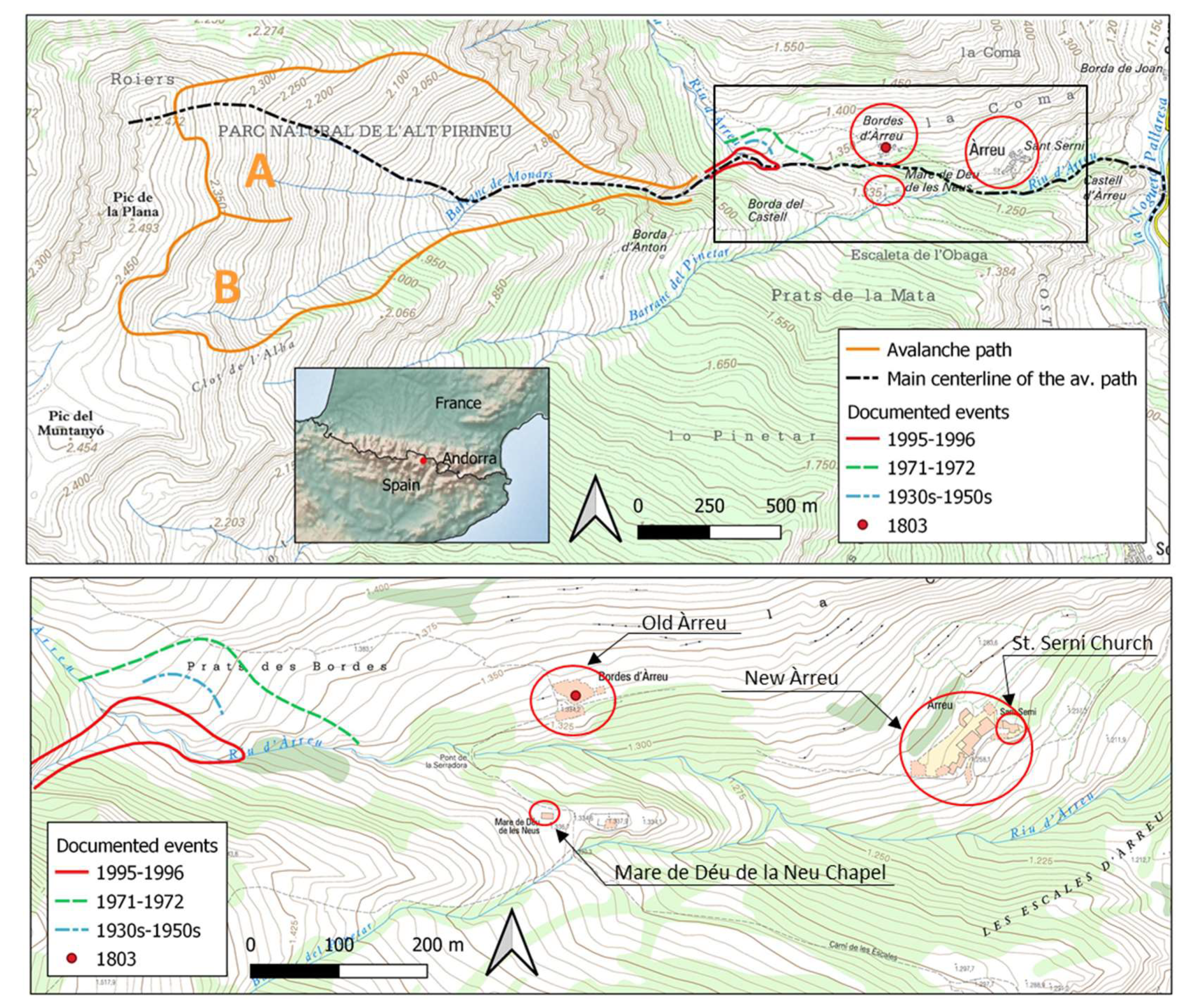
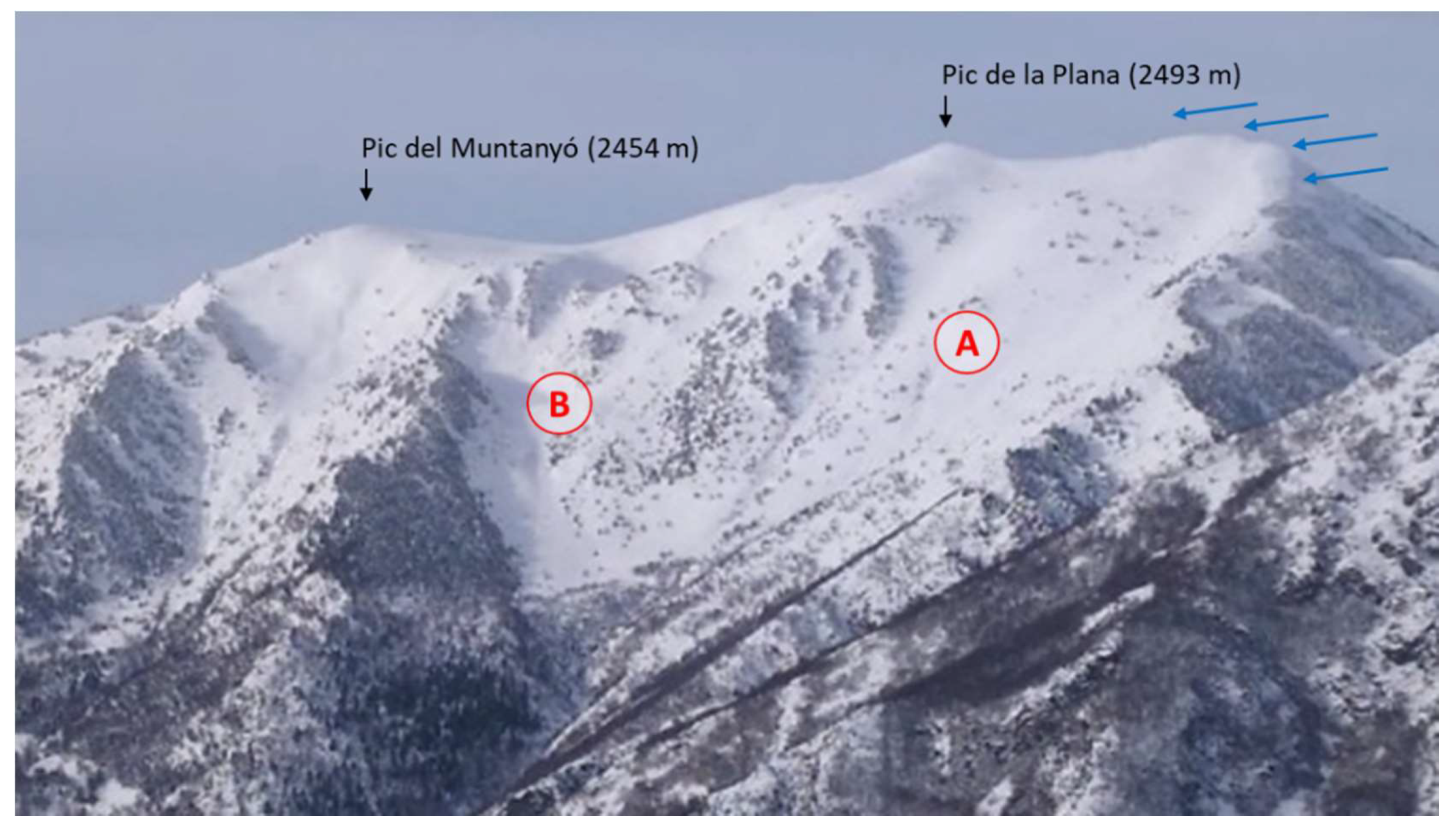
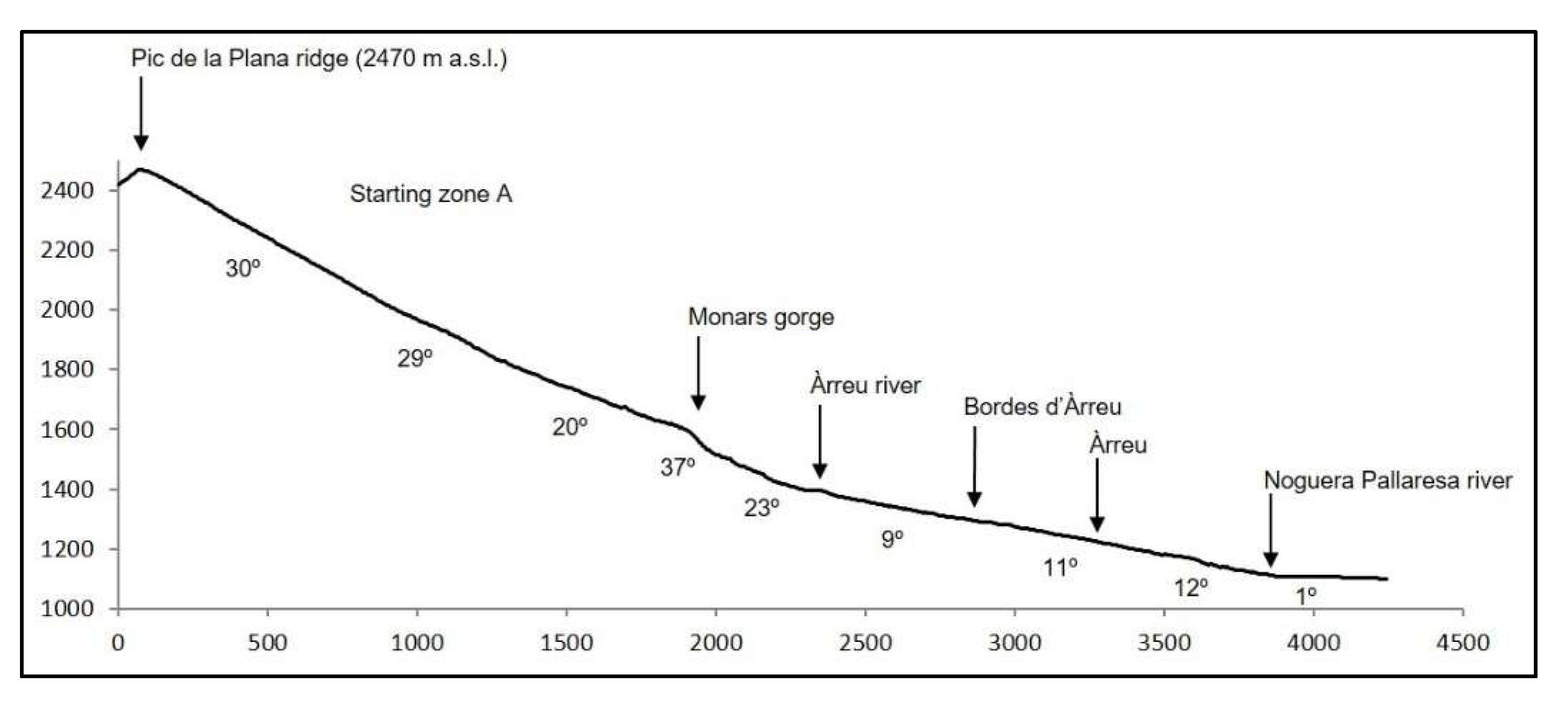
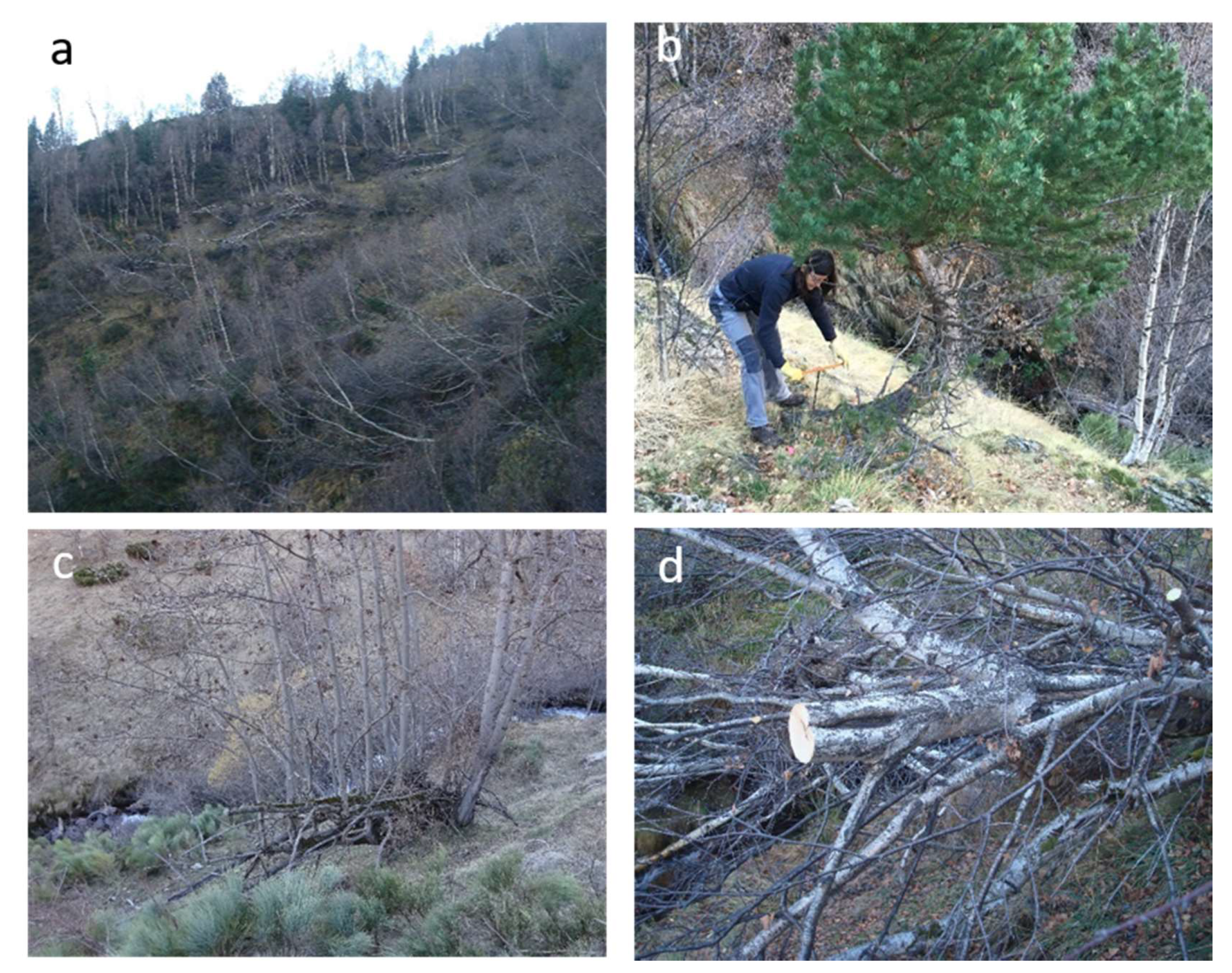
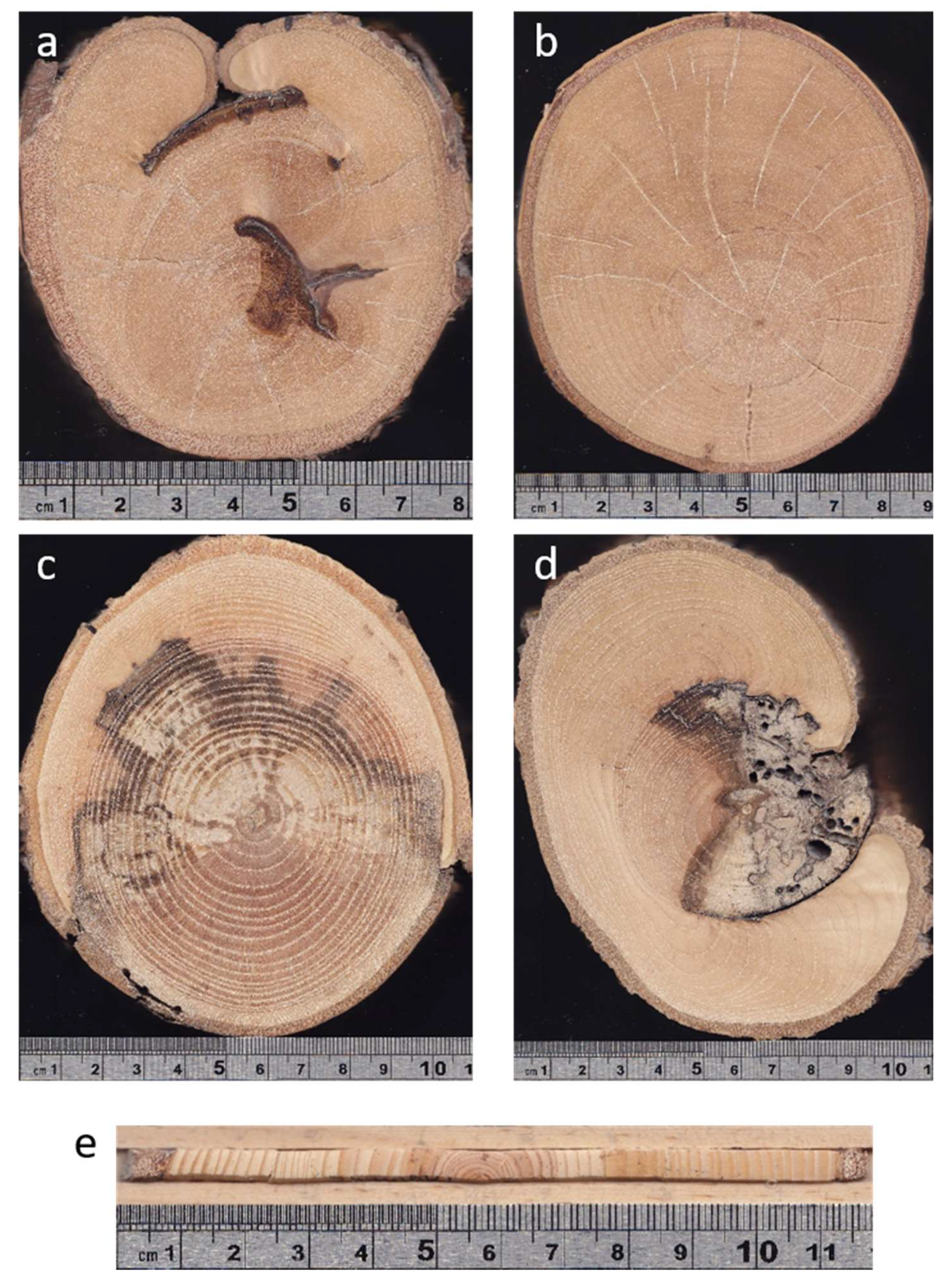
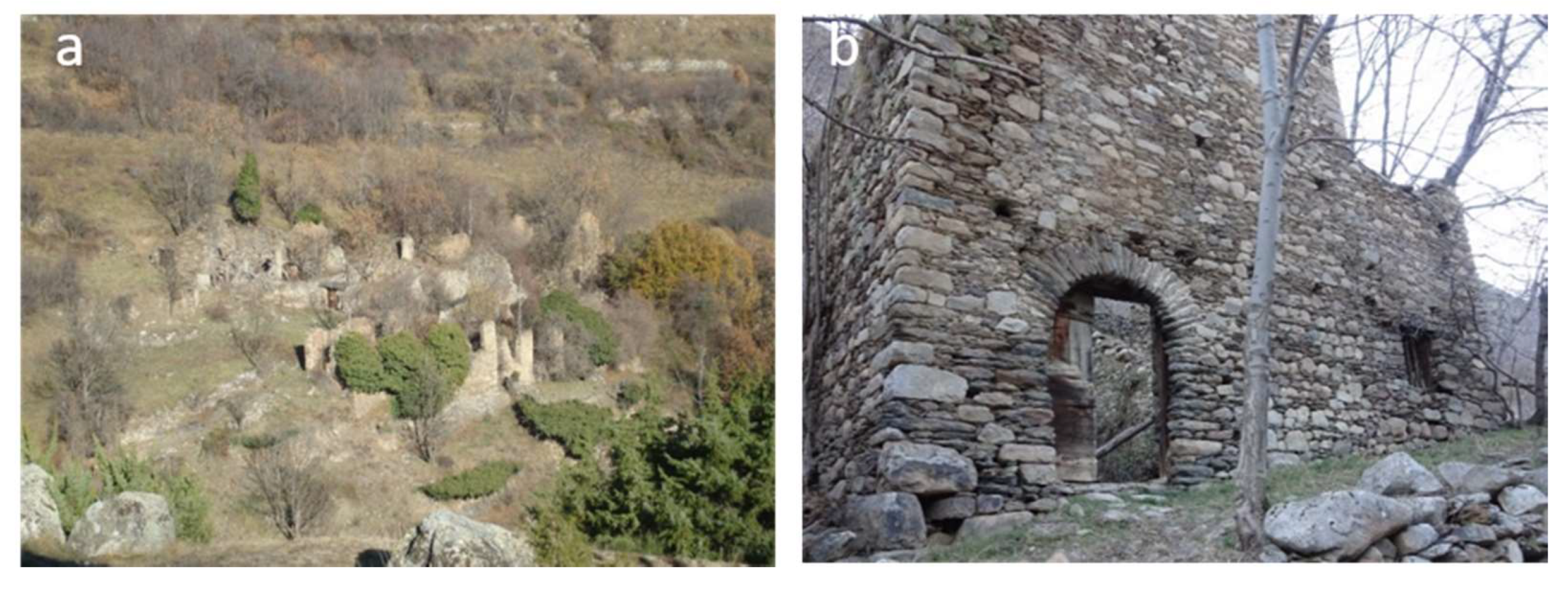
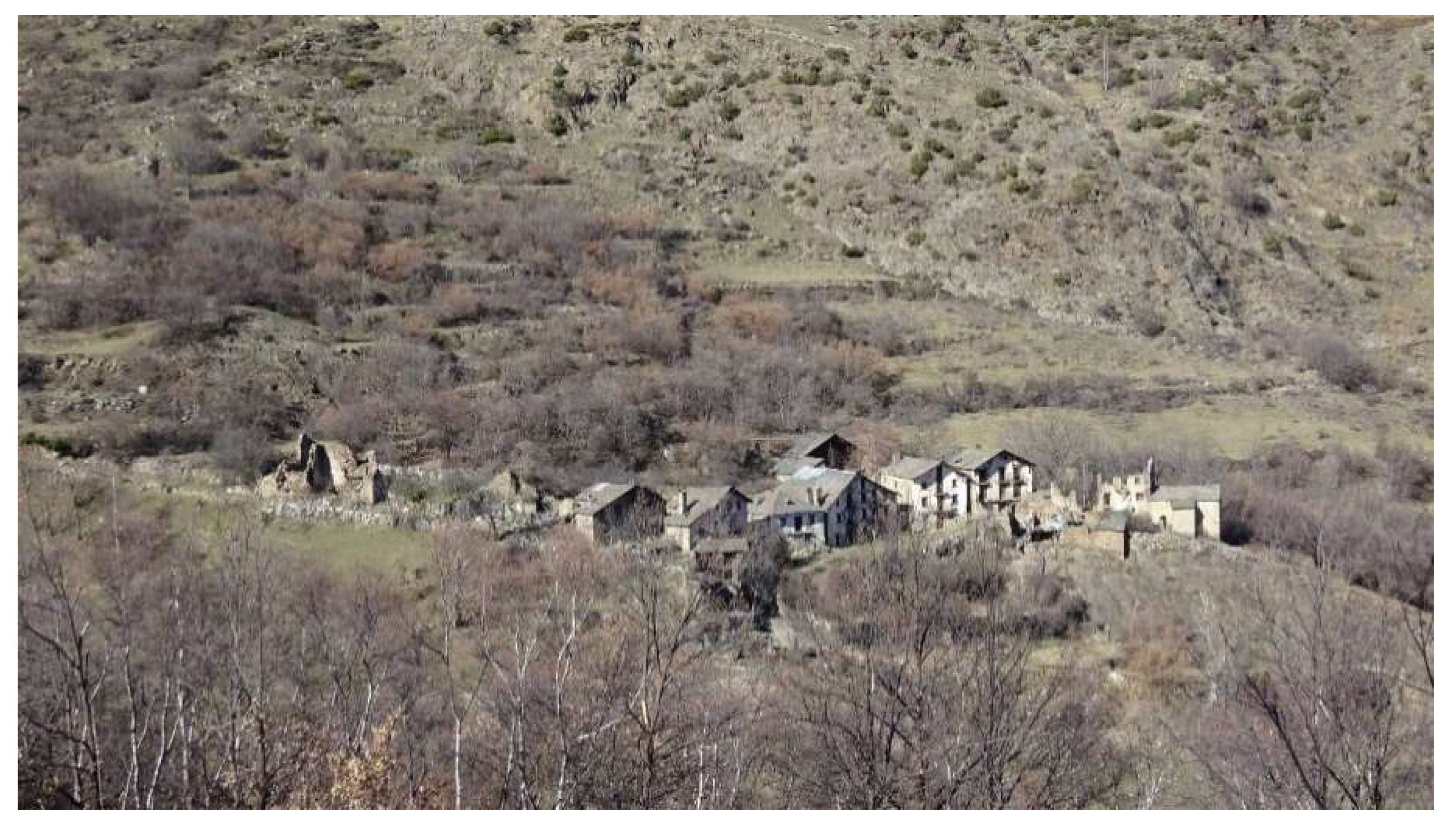

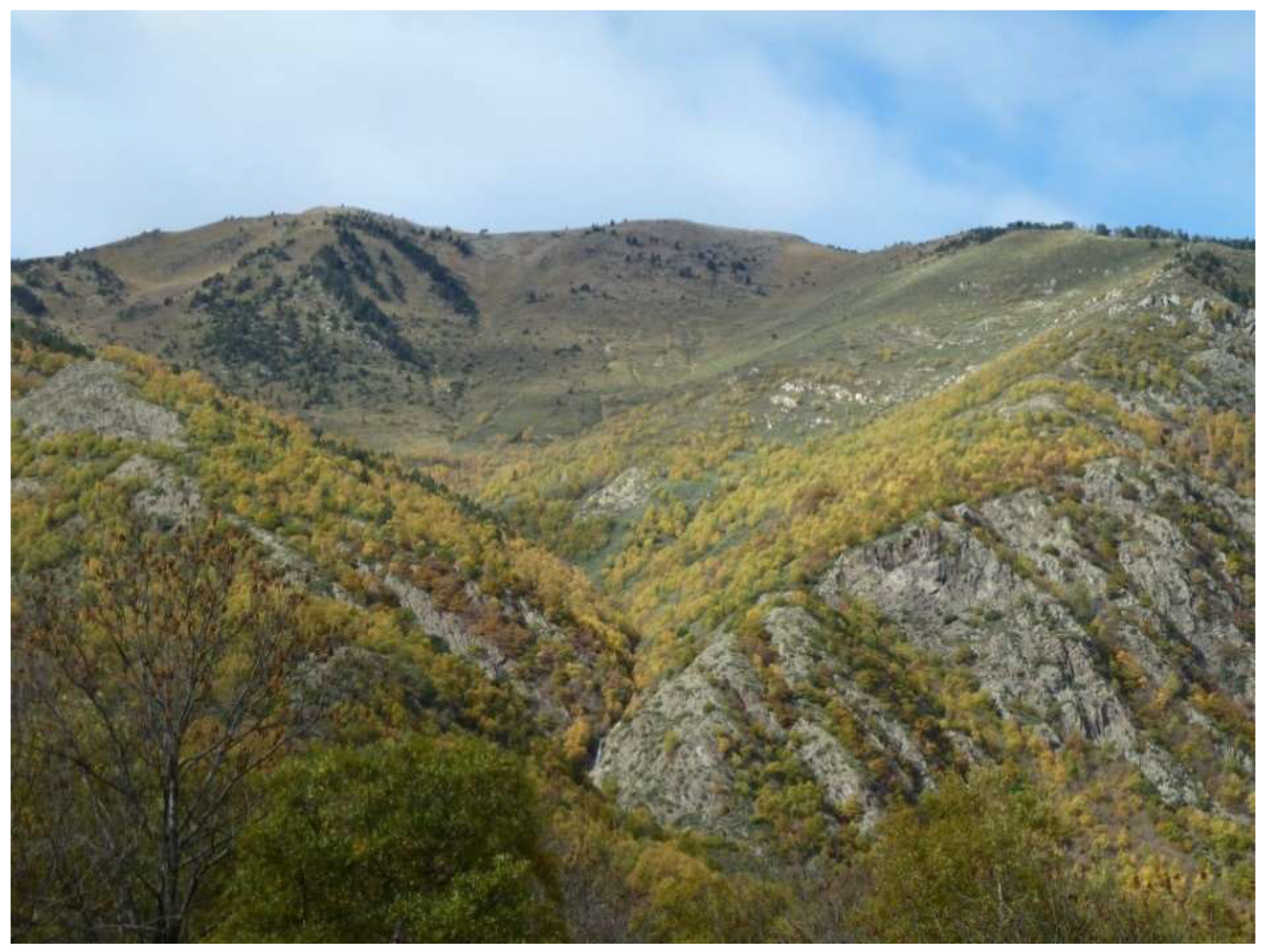
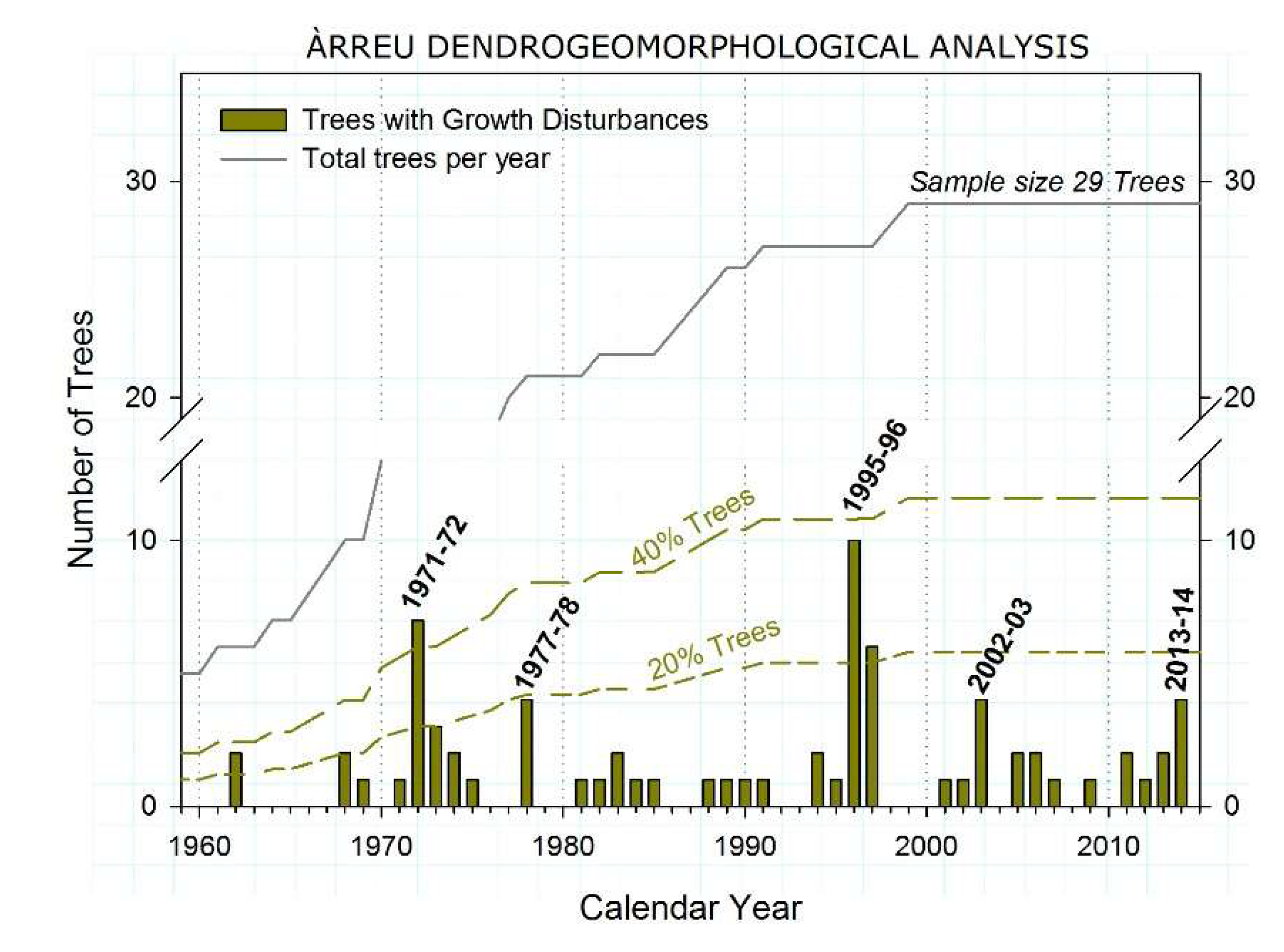
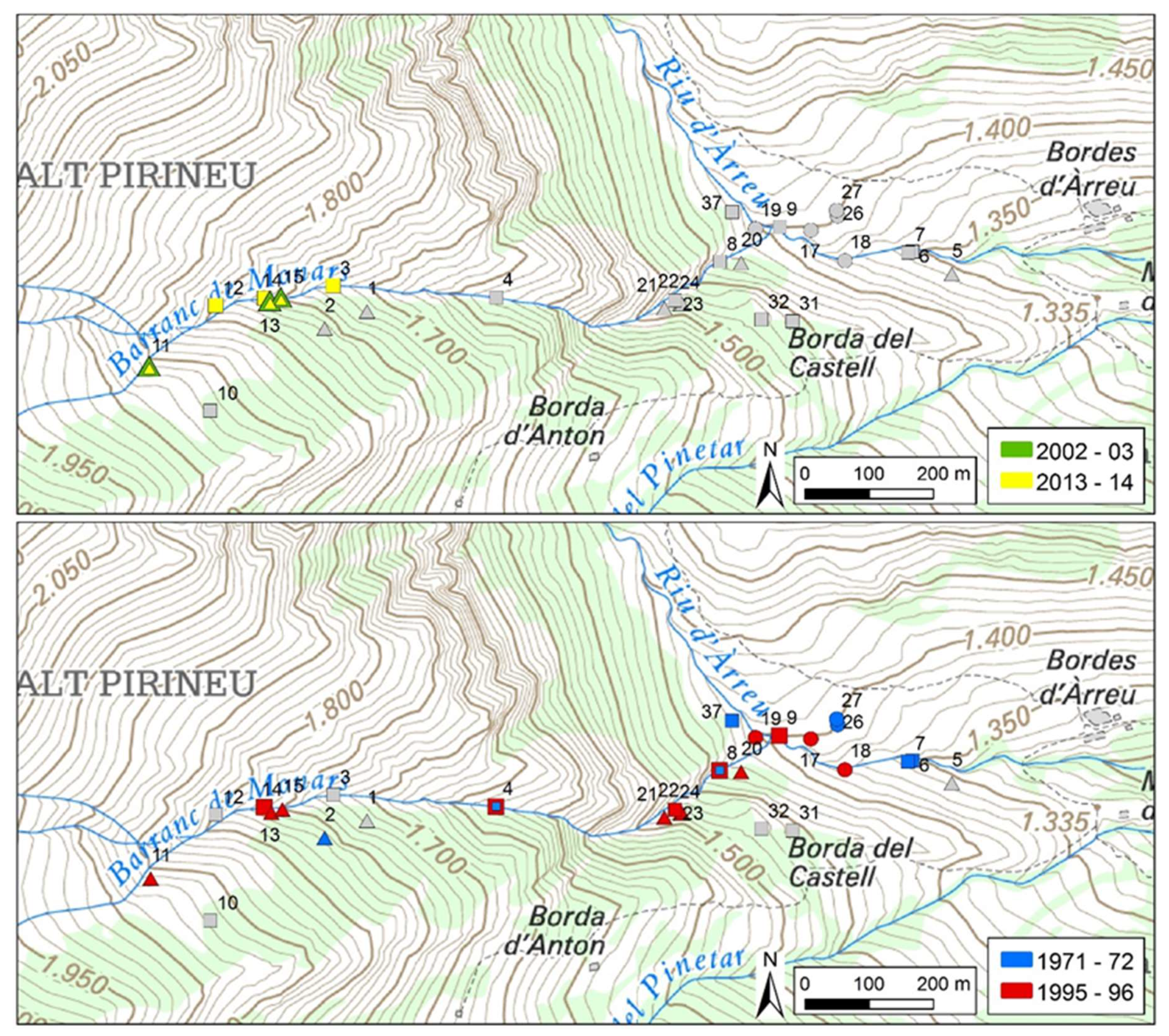
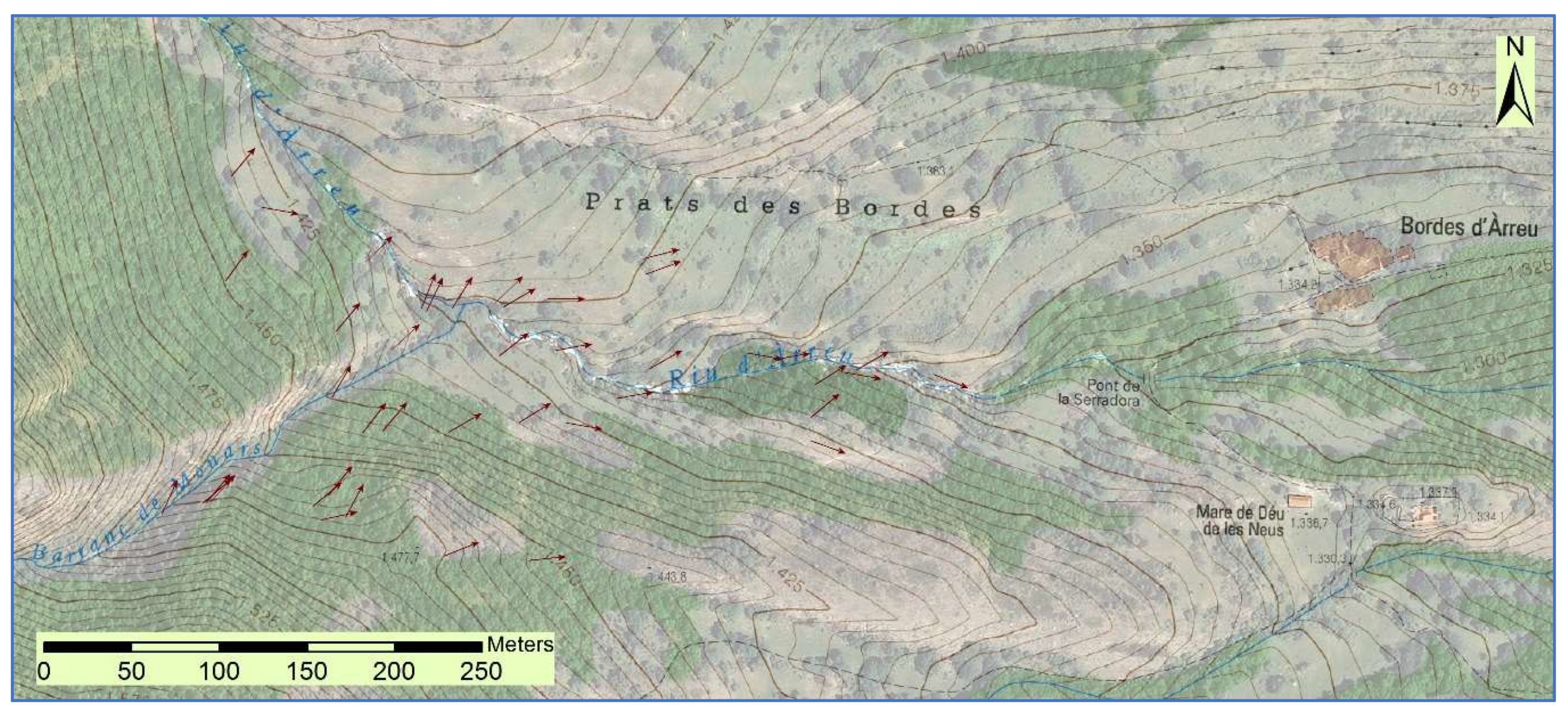
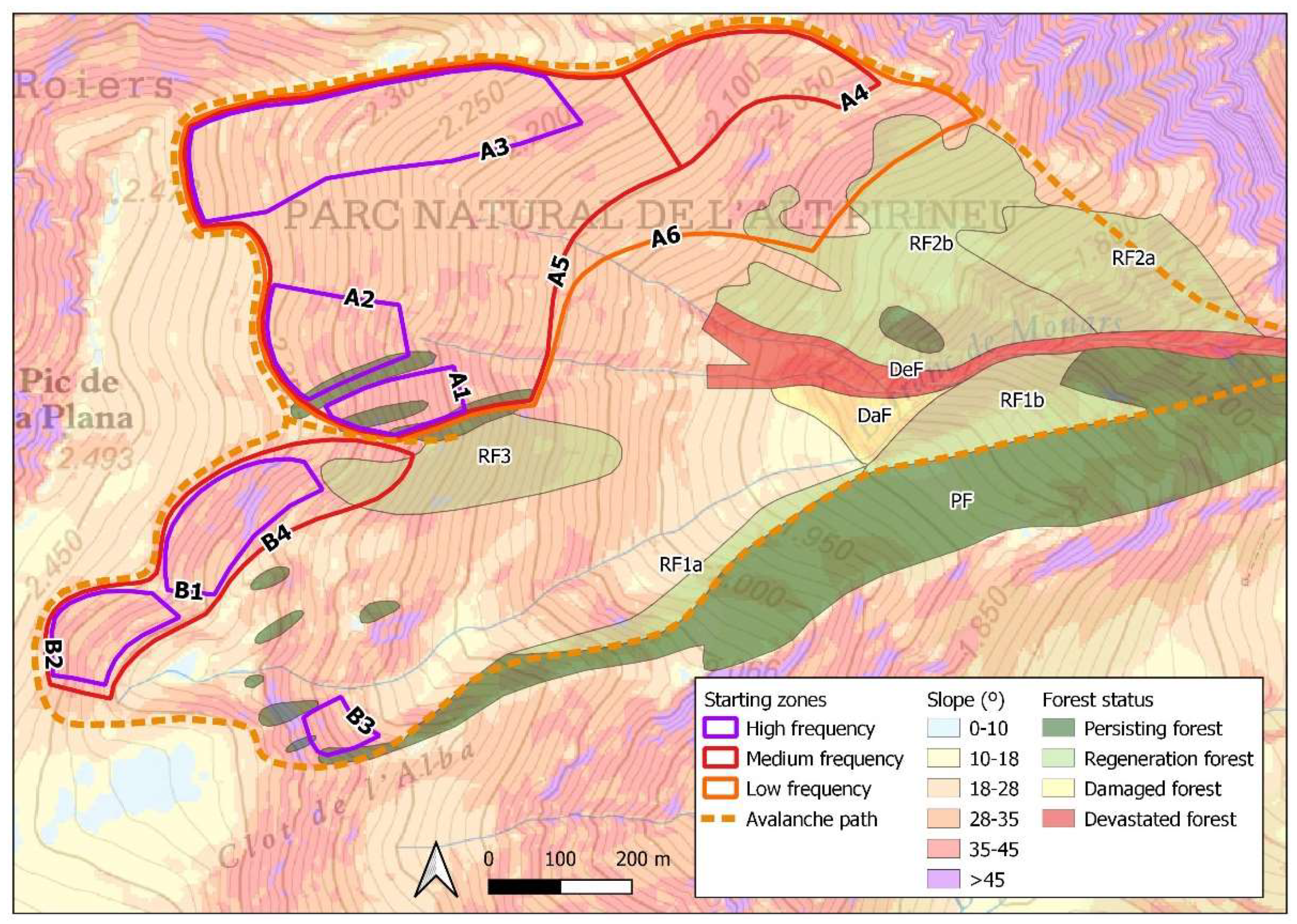
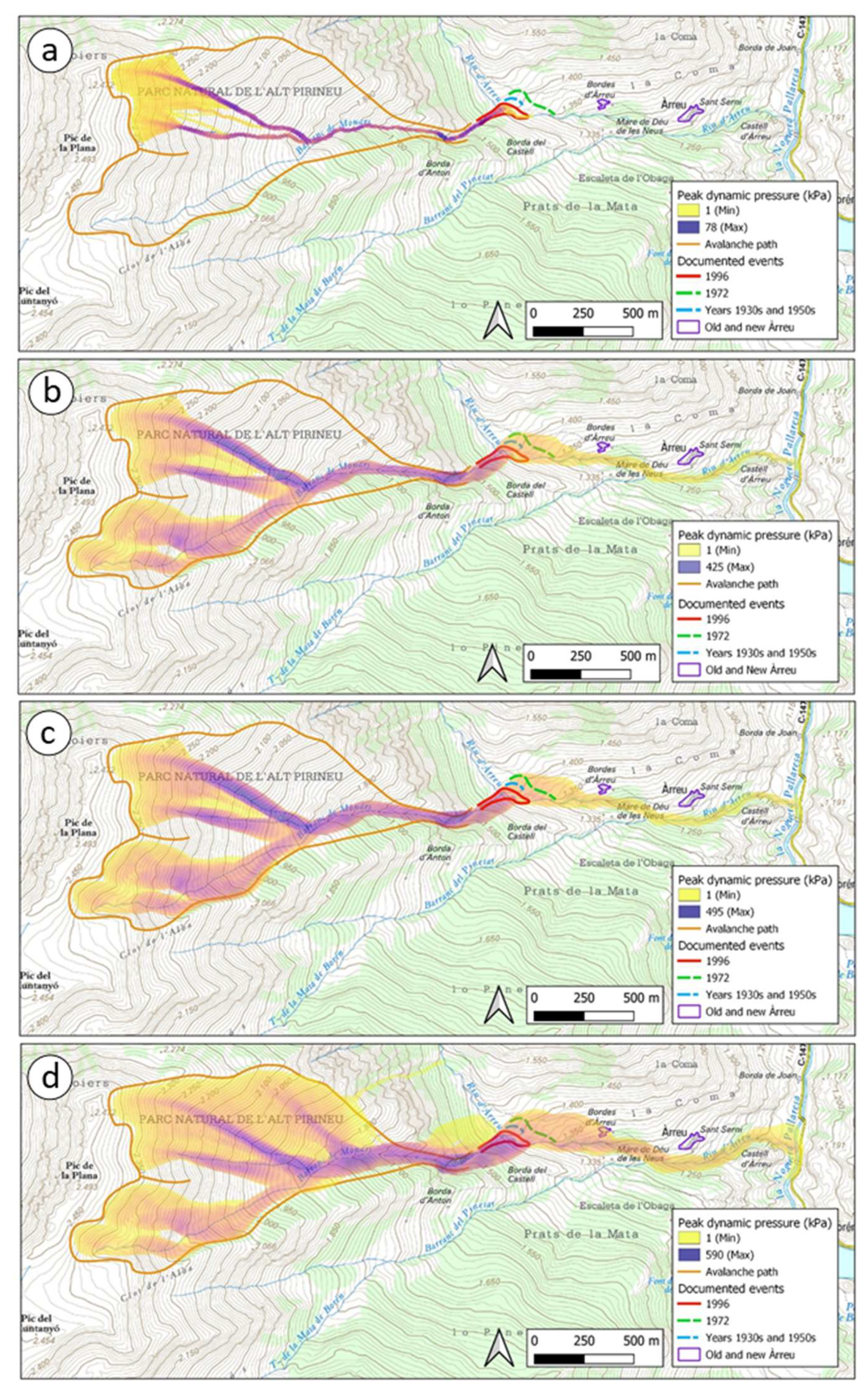
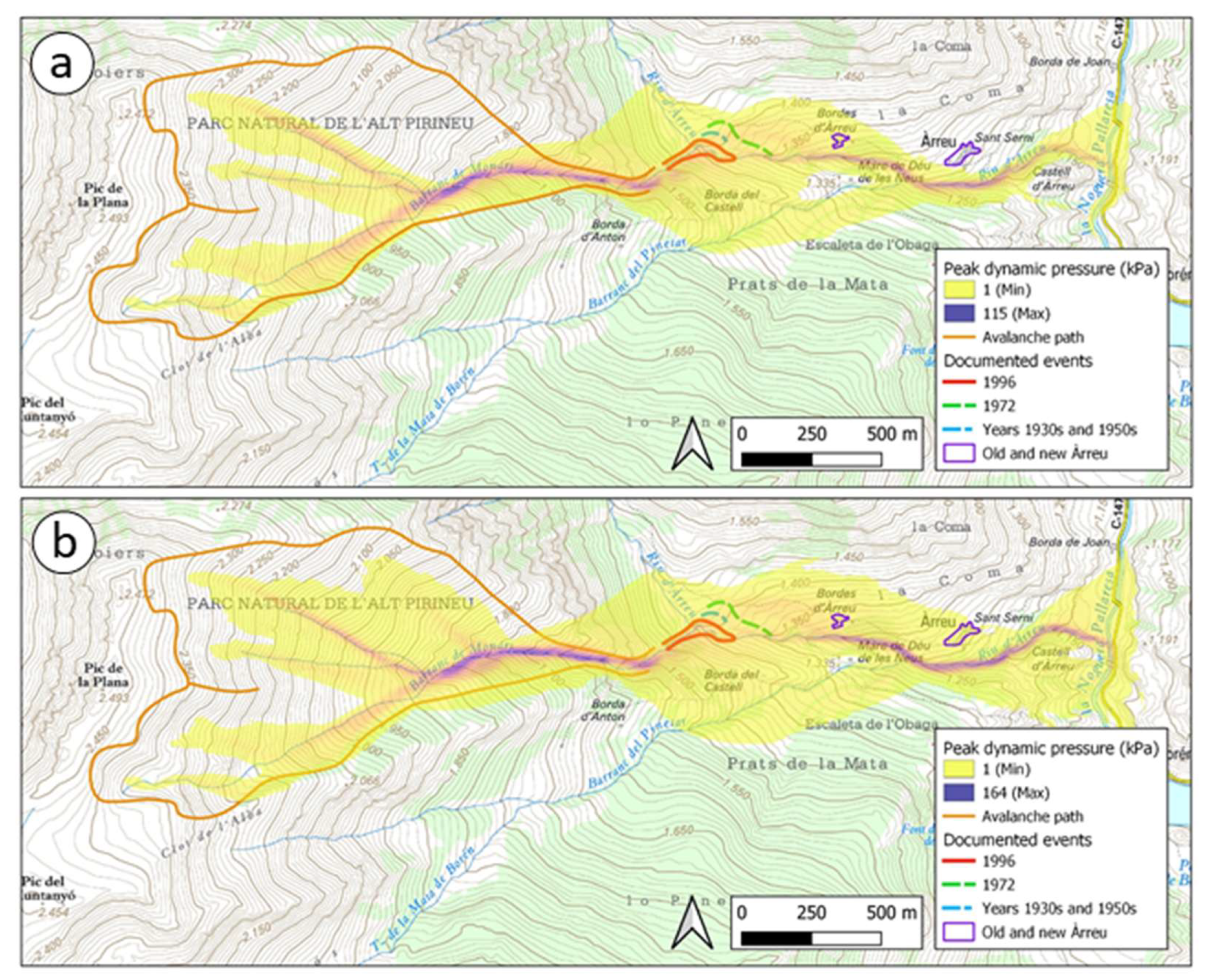
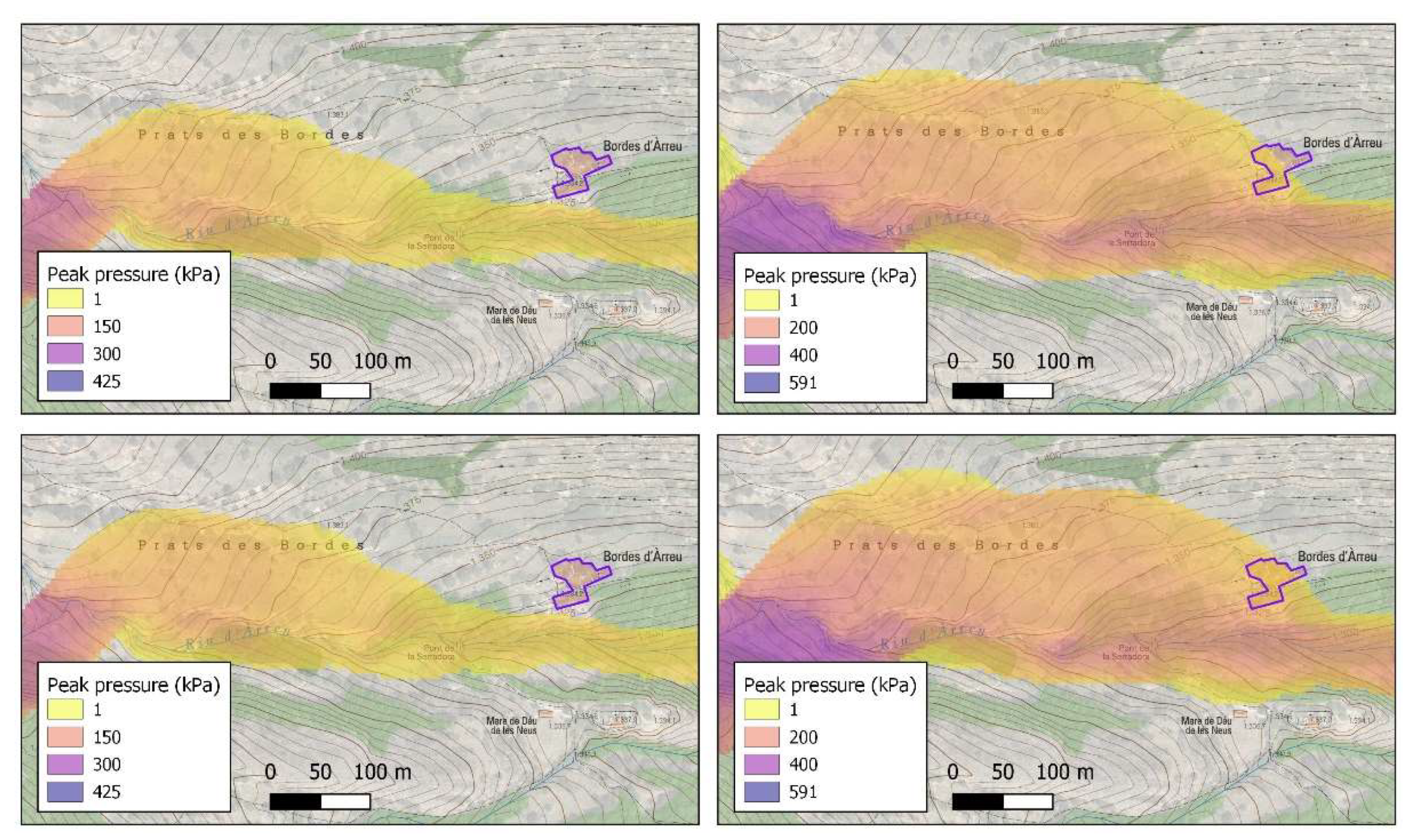

| Reference Runout | Elevation (m a.s.l.) | Estimated Return Period (T, years) |
|---|---|---|
| 2002–03, 2013–14 | 1650 | 5–6 |
| 1996, 1930s, 1950s | 1370 | 25–30 |
| 1971–72 | 1350 | 30–100 |
| 1803 | <1300 | >100 |
| Starting Zone | Mean Slope Angle (°) | Aspect | Area (ha) | Estimated Activity | |||
|---|---|---|---|---|---|---|---|
| 1971–72 | 1995–96 | 2002–03 | 2013–14 | ||||
| A1 | 38 | E | 1.12 | Pb | Pb | Uk | Pb |
| A2 | 33 | E | 2.16 | Pb | Pb | Uk | Pb |
| A3 | 31 | E, SE | 6.27 | Pb | Pb | Uk | Pb |
| A4 | 36 | SE | 3.37 | Pb | Ps | Ul | Ul |
| B1 | 39 | SE | 2.14 | Pb | Ps | Ps | Ps |
| B2 | 35 | SE | 1.42 | Ps | Ps | Uk | Ps |
| B3 | 39 | NE | 0.47 | Ps | Ps | Uk | Ps |
| Release Area | Type of Dynamics | Release Snow Depth Return Period (Years) | Volume Range (m3) | Peak Pressure in Old Àrreu (kPa) | |
|---|---|---|---|---|---|
| with Previous Event | without Previous Event | ||||
| Mid-Frequency | DFA 1 | 30 | 192 × 103 | 0 | 0 |
| PSA 2 | 30 | 192 × 103 | * | <7 | |
| DFA | 300 | 260 × 103 | 0 | 0 | |
| PSA | 300 | 260 × 103 | * | <8 | |
| Low-Frequency | DFA | 30 | 603 × 103 | <150 | <110 |
| PSA | 30 | 603 × 103 | * | <17 | |
| DFA | 300 | 816 × 103 | <191 | <182 | |
| PSA | 300 | 816 × 103 | * | <25 | |
© 2020 by the authors. Licensee MDPI, Basel, Switzerland. This article is an open access article distributed under the terms and conditions of the Creative Commons Attribution (CC BY) license (http://creativecommons.org/licenses/by/4.0/).
Share and Cite
Oller, P.; Fischer, J.-T.; Muntán, E. The Historic Avalanche that Destroyed the Village of Àrreu in 1803, Catalan Pyrenees. Geosciences 2020, 10, 169. https://doi.org/10.3390/geosciences10050169
Oller P, Fischer J-T, Muntán E. The Historic Avalanche that Destroyed the Village of Àrreu in 1803, Catalan Pyrenees. Geosciences. 2020; 10(5):169. https://doi.org/10.3390/geosciences10050169
Chicago/Turabian StyleOller, Pere, Jan-Thomas Fischer, and Elena Muntán. 2020. "The Historic Avalanche that Destroyed the Village of Àrreu in 1803, Catalan Pyrenees" Geosciences 10, no. 5: 169. https://doi.org/10.3390/geosciences10050169
APA StyleOller, P., Fischer, J.-T., & Muntán, E. (2020). The Historic Avalanche that Destroyed the Village of Àrreu in 1803, Catalan Pyrenees. Geosciences, 10(5), 169. https://doi.org/10.3390/geosciences10050169




